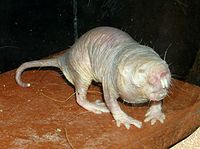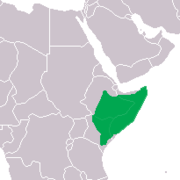Naked mole rat
From Wikipedia, the free encyclopedia
| Naked mole rat Fossil range: Early Pliocene - Recent |
||||||||||||||||
|---|---|---|---|---|---|---|---|---|---|---|---|---|---|---|---|---|
 |
||||||||||||||||
| Conservation status | ||||||||||||||||
| Scientific classification | ||||||||||||||||
|
||||||||||||||||
| Binomial name | ||||||||||||||||
| Heterocephalus glaber Rüppell, 1842 |
||||||||||||||||
 Distribution of the Naked Mole Rat
|
The naked mole rat (Heterocephalus glaber), also known as the sand puppy, or desert mole rat is a burrowing rodent native to parts of East Africa and the only species currently classified in genus Heterocephalus. It is notable for its eusocial lifestyle, nearly unique among mammals (only the Damaraland mole rat shares the trait), and for a highly unusual set of physical traits that enables it to thrive in a harsh, underground environment; including a lack of pain sensation in its skin, and a nearly cold-blooded metabolism.
Contents |
[edit] Physical description
Typical individuals are 8–10 cm long and weigh 30–35 g. Queens are larger and may weigh well over 50 g, the largest reaching 80 g. They are well-adapted for their underground existence. Their eyes are just narrow slits, and consequently their eyesight is poor. However, they are highly adapted to moving underground, and can move backward as fast as they can move forward. Their large, protruding teeth are used to dig. Their lips are sealed just behind their teeth while digging to avoid filling their mouths with soil. Their legs are thin and short. They have little hair (hence the common name) and wrinkled pink or yellowish skin.
The naked mole rat is well adapted for the limited availability of oxygen within the tunnels that are its habitat: its lungs are very small and its blood has a very strong affinity for oxygen, increasing the efficiency of oxygen uptake. It has a very low respiration and metabolic rate for an animal of its size, thus using oxygen minimally. In long periods of hunger, such as a drought, its metabolic rate can reduce by up to 25 percent.
The naked mole rat is unique among mammals in that it is effectively cold-blooded. It cannot regulate its body temperature in the typical mammalian fashion. Instead it relies solely on behavioural means to keep a constant temperature. When they're cold, naked mole rats will huddle together or bask in the shallow parts of their burrow systems. When they get too hot they retreat to the deeper, cooler parts of their tunnel system.[2]
The skin of naked mole rats lacks a key neurotransmitter called Substance P that is responsible in mammals for sending pain signals to the central nervous system. When naked mole rats are exposed to acid or capsaicin, they feel no pain. When injected with Substance P, however, the pain signaling works as it does in other mammals, but only with capsaicin and not with the acids. This is proposed to be adaptation to the animal living in high levels of carbon dioxide due to poorly ventilated living spaces, which would cause acid to build up in their body tissues.[3]
[edit] Ecology and behavior
[edit] Distribution and habitat
The naked mole rat is native to the drier parts of the tropical grasslands of East Africa, predominantly South Ethiopia, Kenya, and Somalia.
Clusters averaging 75-80 individuals live together in complex systems of burrows in arid African deserts. The tunnel systems built by naked mole rats can stretch up to two or three miles in cumulative length.[4]
[edit] Social structure and reproduction
Naked mole rat is one of the two species of mammals that exhibit eusociality. They have a complex social structure in which only one female (the queen) and one to three males reproduce, while the rest of the members of the colony function as workers. As in certain bee species, the workers are divided along a continuum of different worker-caste behaviors instead of discrete groups.[4] Some function primarily as tunnellers, expanding the large network of tunnels within the burrow system, and some primarily as soldiers, protecting the group from outside predators.
This eusocial organisation social structure, similar to that found in ants, termites, and some bees and wasps, is very rare among mammals. The Damaraland Mole Rat (Coetomys damarensis) is the only other eusocial mammal currently known.
The relationships between the queen and the breeding males may last for many years. A behaviour called reproductive suppression is believed to be the reason why the other females do not reproduce, meaning that the infertility in the working females is only temporary, and not genetic. Queens live from 13 to 18 years, and are extremely hostile to other females behaving like queens, or producing hormones for becoming queens. When the queen dies, another female takes her place, sometimes after a violent struggle with her competitors.
Males and females are able to breed at one year of age. Gestation is about 70 days. A litter typically ranges from three to twelve pups, but may be as large as 28. The average litter size is 11.[5] In the wild, naked mole-rats usually breed once a year, if the litter survives. In captivity, they breed all year long and can produce a litter every 80 days.[2] The young are born blind and weigh about 2 g. The queen nurses them for the first month; after which the other members of the colony feed them feces until they are old enough to eat solid food.
[edit] Diet
Radicivores,[6] the naked mole rats feed primarily on very large tubers (weighing as much as 1000 times the body weight of a typical mole rat) that they find deep underground through their mining operations, though they also eat their own feces (coprophagia).[4] A single tuber can provide a colony with a long-term source of food—lasting for months, or even years,[4] as they eat the inside but leave the outside, allowing the tuber to regenerate. Symbiotic bacteria in their intestines help them digest the fibres.
[edit] Longevity
The naked mole rat is also of interest because it is extraordinarily long-lived for a rodent of its size (up to 28 years) and holds the record for the longest living rodent.[7] The secret of their longevity is debated, but is thought to be related to the fact that they can shut down their metabolism during hard times, and so prevent oxidative damage. This has been summed up as "They're living their life in pulses."[8]
Due to their extraordinary longevity for such a small rodent, an international effort was put into place to sequence the genome of the naked mole rat.[9]
[edit] Conservation status
Naked mole rats are not threatened. Despite their tough living conditions, naked mole rats are quite widespread and numerous in the drier regions of East Africa. Though seen living up to 20 years, their lifestyles in those situations consist of mostly sleep.
[edit] References in popular culture
The only prominent cultural reference of a naked mole rat is in the cartoon Kim Possible. Kim's partner, Ron Stoppable, has an anthropomorphic naked mole rat named Rufus (voiced by Nancy Cartwright) for a pet. However, for the sake of him as a character, he looks and acts very little like an actual naked mole rat.
[edit] References
- ^ Maree, S. & Faulkes, C. (2008). Heterocephalus glaber. 2008 IUCN Red List of Threatened Species. IUCN 2008. Retrieved on 5 January 2009.
- ^ a b Piper, Ross (2007), Extraordinary Animals: An Encyclopedia of Curious and Unusual Animals, Greenwood Press.
- ^ Park, Thomas J.; et al. (2008). "Selective Inflammatory Pain Insensitivity in the African Naked Mole-Rat (Heterocephalus glaber)". PLoS Biology 6 (1): e13. doi:. PMID 18232734. http://www.pubmedcentral.nih.gov/articlerender.fcgi?artid=2214810.
- ^ a b c d Dawkins, Richard (1976). The Selfish Gene. Oxford University Press. ISBN 0-19-286092-5.
- ^ Counting mole-rat mammaries and hungry pups, biologists explain why naked rodents break the rules, Roger Segelken, Cornell News, August 9, 1999
- ^ Naked Mole Rat The Animal Files. Retrieved 2008-02-09.
- ^ Buffenstein, R & Jarvis, JUM (2002) The Naked Mole Rat--A New Record for the Oldest Living Rodent, Sci. Aging Knowl. Environ., 2002(21), p. pe7, DOI: 10.1126/sageke.2002.21.pe7
- ^ "Ugly Duckling Mole Rats Might Hold Key To Longevity". Sciencedaily.com. 2007-10-16. http://www.sciencedaily.com/releases/2007/10/071015225336.htm. Retrieved on 2009-03-11.
- ^ "Proposal to Sequence an Organism of Unique Interest for Research on Aging: Heterocephalus glaber, the Naked Mole-Rat". Genomics.senescence.info. http://genomics.senescence.info/sequencing/index.html. Retrieved on 2009-03-11.
[edit] External links
| Wikimedia Commons has media related to: Naked Mole Rat |
| Wikispecies has information related to: Naked Mole Rat |
- Page on the Animal Diversity Web
- Article from Walker's Mammals of the World
- Brookfield Zoo with photo
- More photos
- Heterocephalus glaber images at bioimages.vanderbilt.edu
- Naked Mole-rats Hold Clues to Human Aging - LiveScience.com
- Tool use by naked mole-rats
- Naked mole-rat video from the Oregon Zoo
- Naked Mole-rats Immune to Pain
- Naked mole-rat webcam
|
||||||||||||||||


